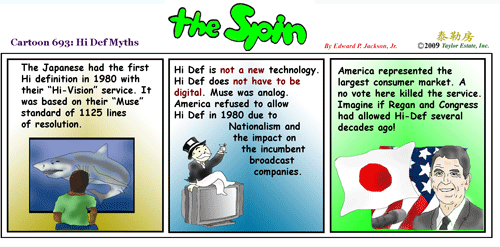 |
|
|
||||||||||||||||||||||||||||||||||
|
Cartoon 693: Hi Def Myths The concept of higher resolution television has been around since the 1970s. Japan had the first working service back in 1980 with its “Hi-Vision” service. The Japanese had developed a 1125 line arrangement codified in a standard called “Muse”. The Japanese had experimented with a number of arrangements to deliver the service. They finally decided on FM modulation (type of analog). There were no real digital networks. High definition is a “resolution” standard. It is the number of lines of image painted on a screen. An ordinary television displays 525 horizontal lines of resolution (America and Canada). There really are two High Definition standards generally mentioned. One is “720p” (720 lines vertically scanned in a progressive fashion). The other is 1080i or p (1,080 lines scanned in an interlaced fashion). There is not enough picture quality difference between the two standards unless you have a very large screen (50 inches plus). If you look really close 1080i is better than 720p. The important thing to know is that High Definition is a resolution standard and it not really married to the transport standard of digital or analog. An analogy: you are moving your seven room household furniture to a house a distance away. The furnishing represent high definition content. You could use a tractor and trailer and move the whole household furnishing at once. The tractor and trailer represents a digital delivery format. The other option is use a pickup truck to move your furnishings. It will take many trips and a lot longer to move your furnishings. This represents an analog delivery of high definition today. For technical reasons of bandwidth utilization, digital is the preferred transport medium for high definition (now). But remember the times when the Japanese High Definition was an issue. Americans were being overwhelmed with the invasion of superior Japanese technology. This included the Walkman, cars, VCRs and many other things. A backlash was in the works. Therefore, even though the Japanese had a working service that could be exported here, it was “dead on arrival”. The other thing that occurred was the lobbying by the broadcast networks. The broadcast networks would have to invest in new infra-structure for the service. Cable television at that time was a niche market and not a major player. Why are we now going digital after decades of delay? The answer is money. The broadcast incumbents were not going to allow it until they could profit. They now profit from “Content” [shows and movies]. Disney owns ABC and Pixar (animated graphics movie company). CBS owns ShowTime and is in turn owned by Viacom. Viacom owns Paramount Pictures and DreamWorks. NBC owns Universal Studios. Time Warner owns HBO. They waited for the build out to digital networks by others such as Comcast, Verizon, AT&T and Time Warner. They all believe they can plunder the “content” gold mine. But there is a dark cloud over this American story. The other Western nations and Asia do not consider American “broadband” to be broadband. It is far too slow and lacks through put (how much can get through the pipe). Everyone else is many times faster. The problem is like America claiming it has a bullet train when the average speed is less than a hundred miles an hour. Throughout the world a bullet train is one with an average speed approaching 170 miles an hour. America will never reach those speeds with its current century old designed rail infra-structure. In the case of broadband I will use a parable. You are speeding along a multilane highway (think Autobahn) with speeds of 110 miles an hour. Suddenly you get to America. There are big flashy signs saying broadband. But after you stop and pay a high toll you are on a single lane dirt road. The flashy signs are going up celebrating America’s achievement of going all digital with its television. The rest of the world is laughing. We cannot participate in evolving 21st century media traveling on a dirt road.
|

